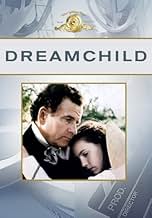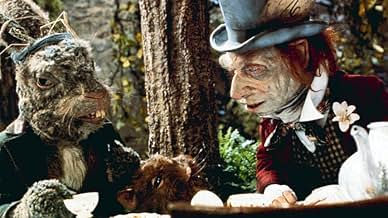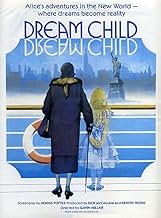ÉVALUATION IMDb
6,6/10
1,8 k
MA NOTE
Ajouter une intrigue dans votre langueIan Holm is children's author Lewis Carroll in this poignant fantasy-drama set in 1930s New York and populated by the fabulous special effects creatures of Muppet master Jim Henson.Ian Holm is children's author Lewis Carroll in this poignant fantasy-drama set in 1930s New York and populated by the fabulous special effects creatures of Muppet master Jim Henson.Ian Holm is children's author Lewis Carroll in this poignant fantasy-drama set in 1930s New York and populated by the fabulous special effects creatures of Muppet master Jim Henson.
- Nominé pour le prix 2 BAFTA Awards
- 7 victoires et 6 nominations au total
Histoire
Le saviez-vous
- AnecdotesBecause its American theatrical release was limited, and she was extremely proud of this movie, Coral Browne went on a self-funded promotional tour.
- GaffesDuring the tea dance Jack and Lucy waltz to "I Only Have Eyes For You." The scene is set in 1932, but the song was not written until 1934.
- Citations
Alice Hargreaves: That's quite intolerable. It would be difficult enough at my age to be what I once was, but utterly impossible to be what I never was.
- ConnexionsFeatured in At the Movies: The Trip to Beautiful/Ran/Clue/Dreamchild (1985)
- Bandes originalesAll of Me
(uncredited)
Music by Gerald Marks
Lyrics by Seymour Simons
Performed by a vocalist with the ship's band
Commentaire en vedette
I don't put much stock in the central conceit shared in "Dreamchild" that Charles Dodgson was a pedophile in love with Alice Liddell, the real-life inspiration for his Alice books. Regardless, this theory serves the film well--better than it did in Dennis Potter's prior TV "Alice" (1965). It's one of the more disturbing adaptations or reworkings of the famous children's books, and that includes the grotesque puppetry from Jim Henson's Creature Shop, which otherwise is best known for kiddie fare such as The Muppets franchise. "Dreamchild" is also one of the more interesting cinematic translations to incorporate the historical background into the telling of parts from the books. Others have tended to limit this to a framing narrative, as in the 1949 and 1972 versions. The "reality" and fantasy in "Dreamchild," however, are comparatively well integrated.
The main narrative has Alice Liddell, now the nearly-80-years-old and widowed Mrs. Hargreaves, traveling to New York to receive an honorary degree to mark the centenary of Lewis Carroll's birth. While in the states, she's hounded by the press (the gaggle of fast-talking, cynical Depression-era reporters being an imitation straight out of "The Front Page") and forced to recall her childhood encounters with Mr. Dodgson and selections from the book he wrote for her. Underlying the dreams from book is a competent interpretation of "Alice's Adventures in Wonderland." Beyond the amusing nonsense, the fictional Alice's physical transformations--alternately growing bigger and smaller--is translated as an allegory for aging, with the movie's Alice changing between her as a child and as an old woman in her interactions with Wonderland's inhabitants. These characters remain partially nasty or threatening to Alice, as per the literary source, which likewise is read as representing one's (originally, a child's) struggle to make sense of the adult world, or, in this case, also the Depression-era modernity of the New World and Alice's reckoning with her past relationship with the author.
All of this is reflected in two plotlines involving older men and their advances towards younger females. In the modern timeline, one of the reporters begins a romantic relationship with Alice's travel companion, Lucy, and, in the past, there's Dodgson's questionable intentions towards young Alice. "Dreamchild" largely reduces the author of the greatest books in the history of children's literature to a stuttering girl lover who seems to repress his sexual desires with photography and telling her stories, disregarding much of his other influences and importance of his work, but it's a more sophisticated interpretation of the Alice books than most other movies I've sought out since reading Carroll's stories, and it's certainly one of the more unsettling and mature reimaginings.
The main narrative has Alice Liddell, now the nearly-80-years-old and widowed Mrs. Hargreaves, traveling to New York to receive an honorary degree to mark the centenary of Lewis Carroll's birth. While in the states, she's hounded by the press (the gaggle of fast-talking, cynical Depression-era reporters being an imitation straight out of "The Front Page") and forced to recall her childhood encounters with Mr. Dodgson and selections from the book he wrote for her. Underlying the dreams from book is a competent interpretation of "Alice's Adventures in Wonderland." Beyond the amusing nonsense, the fictional Alice's physical transformations--alternately growing bigger and smaller--is translated as an allegory for aging, with the movie's Alice changing between her as a child and as an old woman in her interactions with Wonderland's inhabitants. These characters remain partially nasty or threatening to Alice, as per the literary source, which likewise is read as representing one's (originally, a child's) struggle to make sense of the adult world, or, in this case, also the Depression-era modernity of the New World and Alice's reckoning with her past relationship with the author.
All of this is reflected in two plotlines involving older men and their advances towards younger females. In the modern timeline, one of the reporters begins a romantic relationship with Alice's travel companion, Lucy, and, in the past, there's Dodgson's questionable intentions towards young Alice. "Dreamchild" largely reduces the author of the greatest books in the history of children's literature to a stuttering girl lover who seems to repress his sexual desires with photography and telling her stories, disregarding much of his other influences and importance of his work, but it's a more sophisticated interpretation of the Alice books than most other movies I've sought out since reading Carroll's stories, and it's certainly one of the more unsettling and mature reimaginings.
- Cineanalyst
- 8 août 2020
- Lien permanent
Meilleurs choix
Connectez-vous pour évaluer et surveiller les recommandations personnalisées
- How long is Dreamchild?Propulsé par Alexa
Détails
- Date de sortie
- Pays d’origine
- Langue
- Aussi connu sous le nom de
- Das wahre Leben der Alice im Wunderland
- Lieux de tournage
- sociétés de production
- Consultez plus de crédits d'entreprise sur IMDbPro
Box-office
- Budget
- 4 000 000 £ (estimation)
- Brut – États-Unis et Canada
- 1 215 923 $ US
- Fin de semaine d'ouverture – États-Unis et Canada
- 5 425 $ US
- 6 oct. 1985
- Brut – à l'échelle mondiale
- 1 215 923 $ US
Contribuer à cette page
Suggérer une modification ou ajouter du contenu manquant

Lacune principale
By what name was Dreamchild (1985) officially released in India in English?
Répondre

































